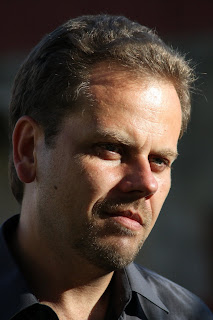Rudolfinum
May 4
The Prague Philharmonia is the most malleable orchestra in town. While the city’s older, more established ensembles have developed trademark sounds, the Philharmonia, just 18 years old and staffed with talented young players, is still finding its voice. So it tends to reflect the strengths and weaknesses of its conductors more than most orchestras.
 |
| A conductor with class. |
That worked to good advantage last night, with Petr Altrichter at the podium. Currently the principal guest conductor of the Brno Philharmonic and a frequent visitor to Prague stages, Altrichter has a distinguished pedigree that includes training under the legendary Václav Neumann at the Czech Philharmonic. He is also a gracious nurturer of young talent, literally stepping aside to put the spotlight on the players and let them bask in the applause, and embracing – again, literally – soloists like Jan Simon, who played Liszt’s Piano Concerto No. 2.
The opening piece was by Iša Krejčí, a 20th-century Czech composer who worked in a neoclassical vein and is known for the optimistic, playful qualities of his music. His Serenade for Orchestra, completed in 1950, is more like a bracing wake-up call, filled with swirling flights of fancy, inventive passages for strings and the pulse and rhythms of modern life. Altrichter came at it full-steam from the opening bars, with energetic bursts of intensity tempered by fine, even delicate work with the woodwinds and strings. In particular, he showed great skill handling contrasting string melodies in the second movement. After a snappy “cha-cha-cha” ending, even the players were applauding the conductor.
Altrichter’s orchestral work was also the most interesting part of the Liszt concerto. He might be criticized for keeping the ensemble pitched to high drama and full volume for what should be a soloist showcase, but for this reviewer, the problem lay more with Simon, a talented technician who did not show much flair. His Liszt was proficient but flat, lacking any of the interpretation lighting up the orchestra behind him. At times, not only the volume but the style of the orchestra completely swallowed Simon’s playing.
 |
| Not much style. |
And his choice of an encore was puzzling: Chopin’s Nocturne in C minor, Op. 48, No. 1. A beautiful but in some ways ponderous piece heavy with grief, it’s short on technical demands and long on expression, which is not the pianist’s strong suit – or at least, wasn’t last night. There’s no arguing with Simon’s credentials; he is a Prague Spring laureate and the winner of a national Chopin competition. But particularly in contrast to the fire of Atrichter’s energetic orchestra, his playing never developed any feeling or depth.
The final work, Mendelssohn-Bartholdy’s Symphony No. 5, gave Altrichter an opportunity to bring all his skills to the fore. He pumped the piece full of energy, keeping it moving along briskly without losing any balance or control. In the second movement, the scherzo, he showed that he can have a light touch when the material calls for it, trading volume for sensitivity. And in the closing coda, Altrichter offered a reminder that he can get a very serious statement from a small number of horns when he needs it.
In some ways, that was the theme of the entire evening: Less is more. With only 50 pieces, the Philharmonia took up about two-thirds of the stage space that most orchestras playing at the Rudolfinum occupy. But it gave away nothing in impact or drama, rendering vivid colors throughout the entire evening. After seeing Altrichter conduct Prague’s larger orchestras, this was like watching him take a high-performance sports car for a ride. It handled smoothly, responded beautifully and sounded every bit as good as its Cadillac counterparts.
For more on Petr Altrichter: http://www.hazardchase.co.uk/artists/petr_altrichter
And a brief history of the orchestra: http://www.pkf.cz/en/profile.html
No comments:
Post a Comment